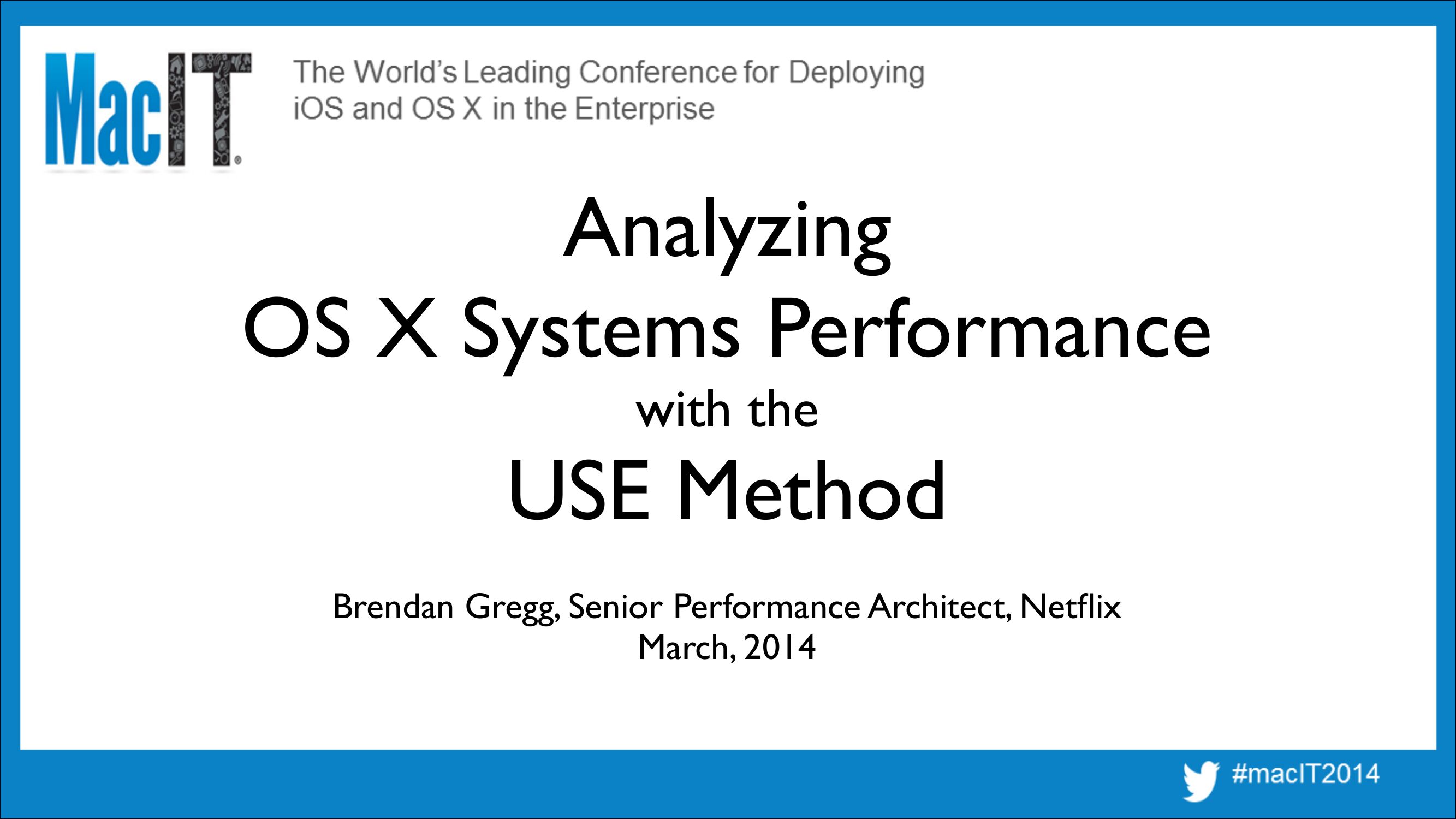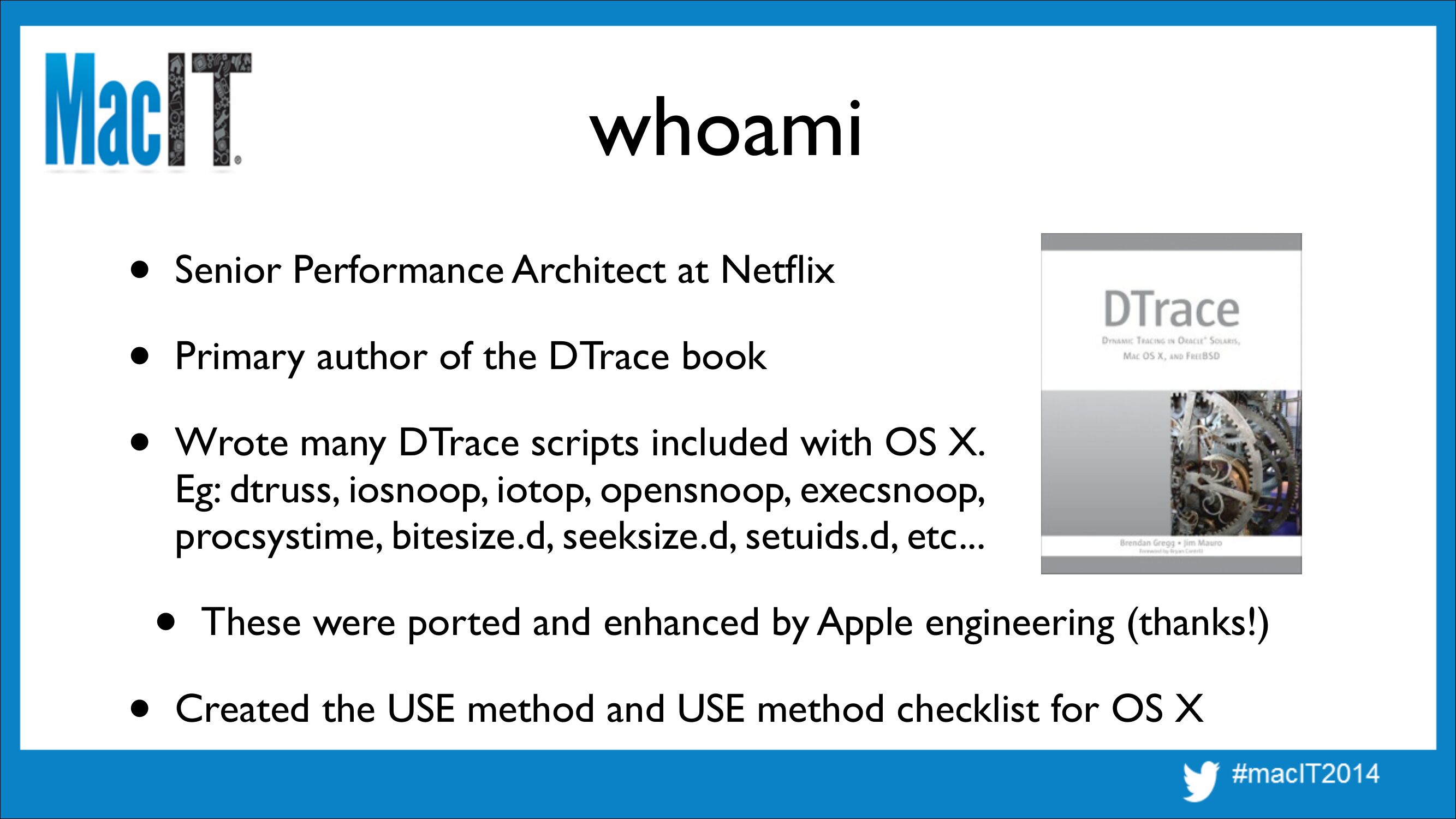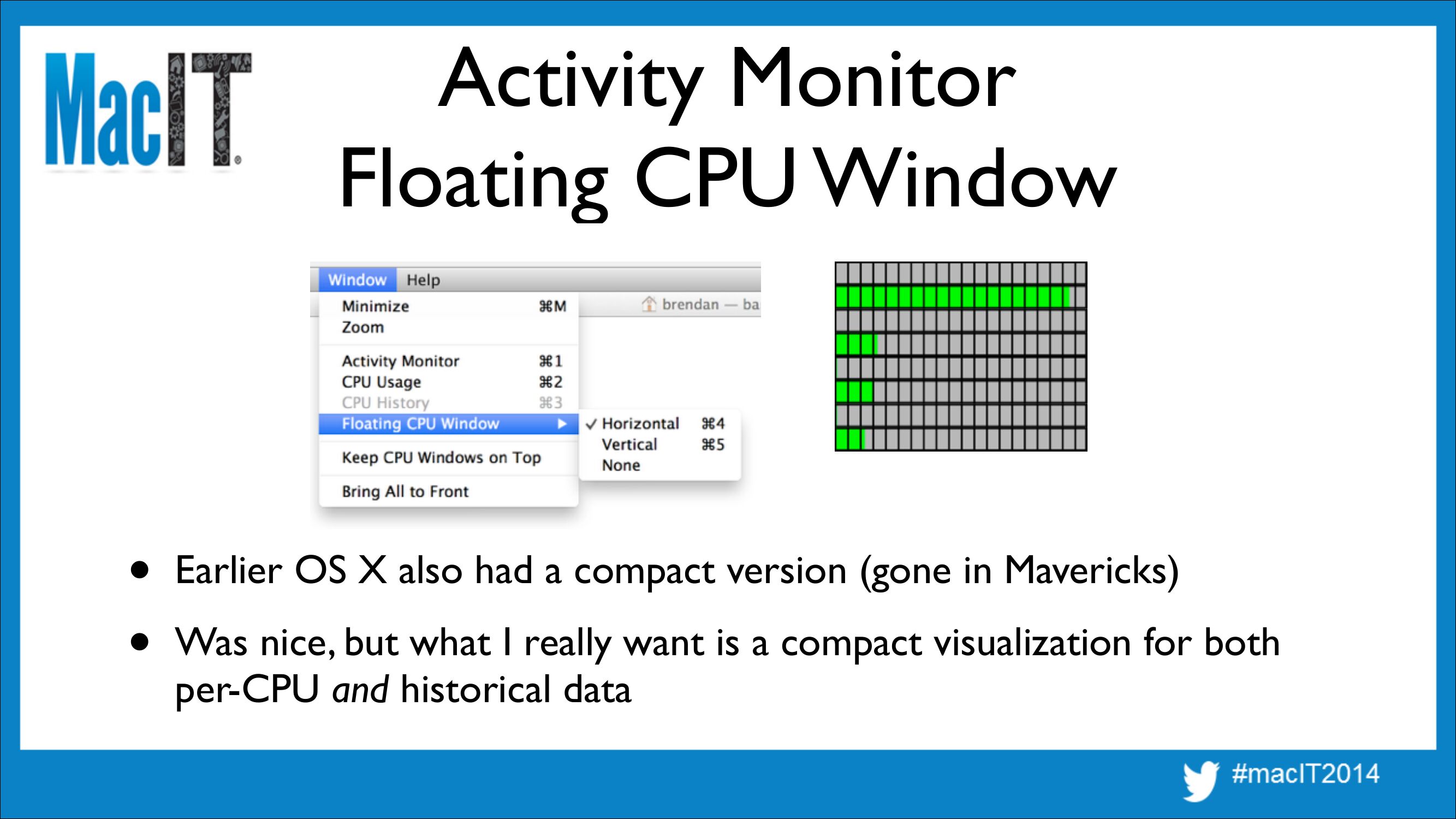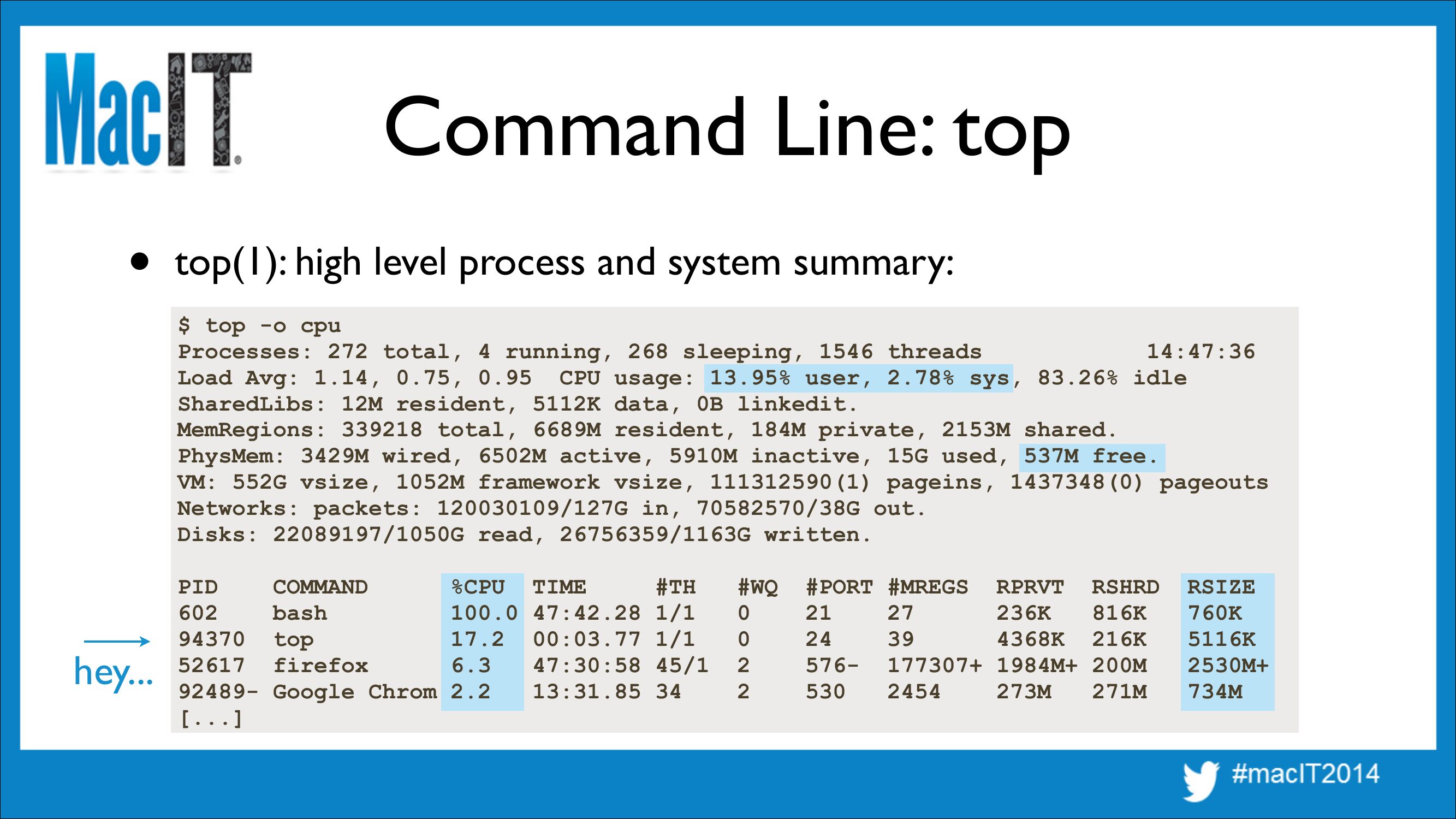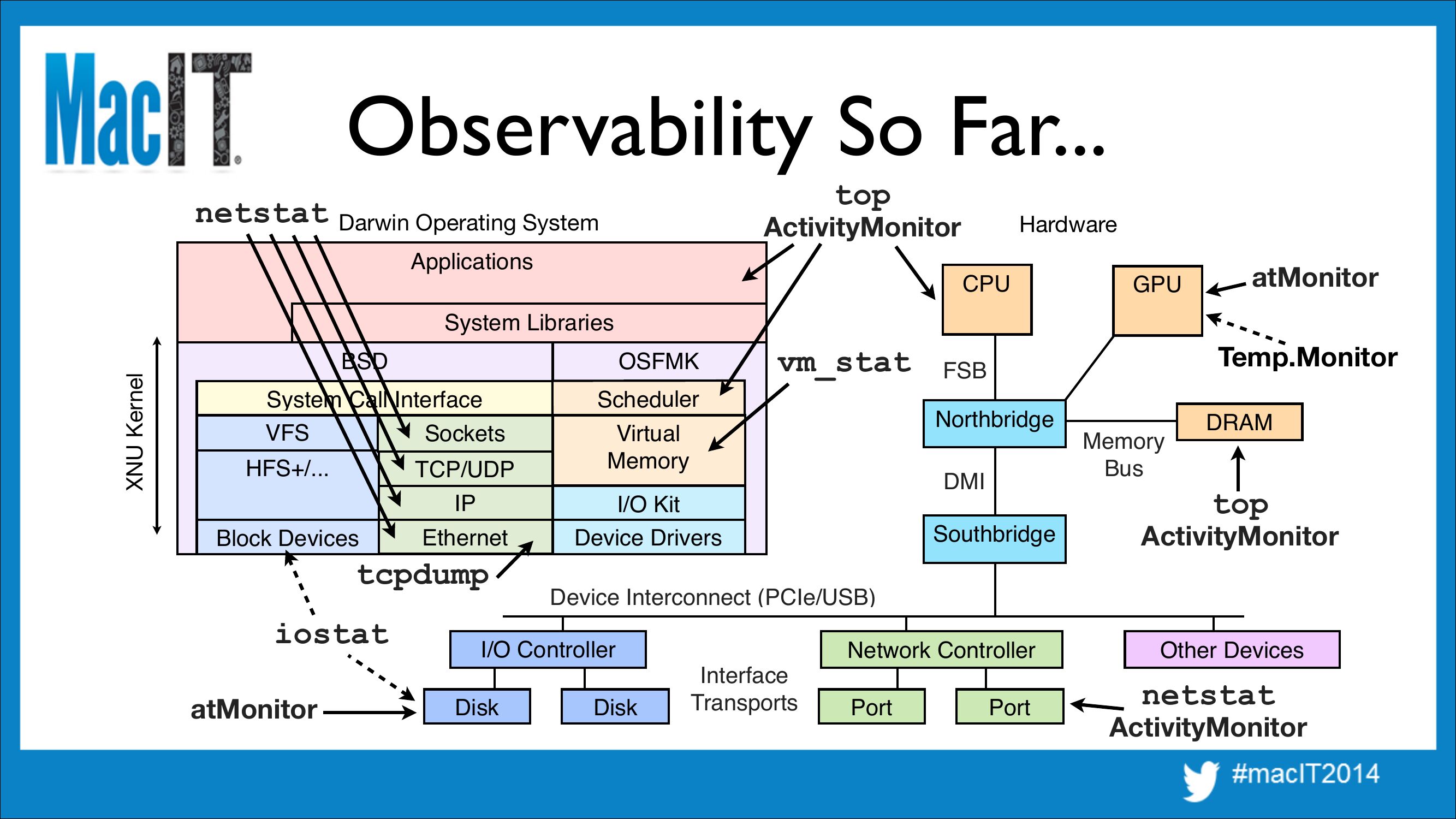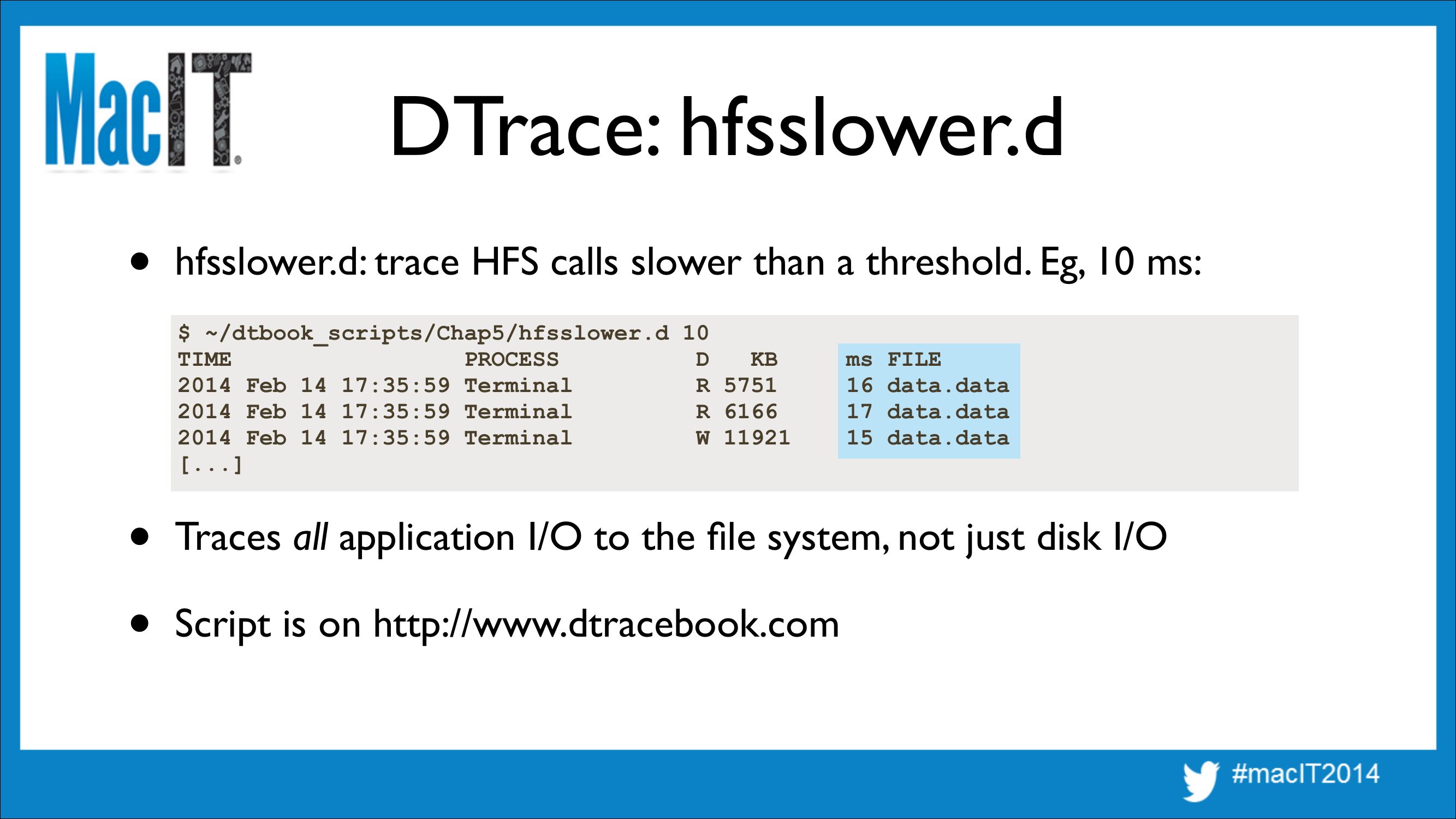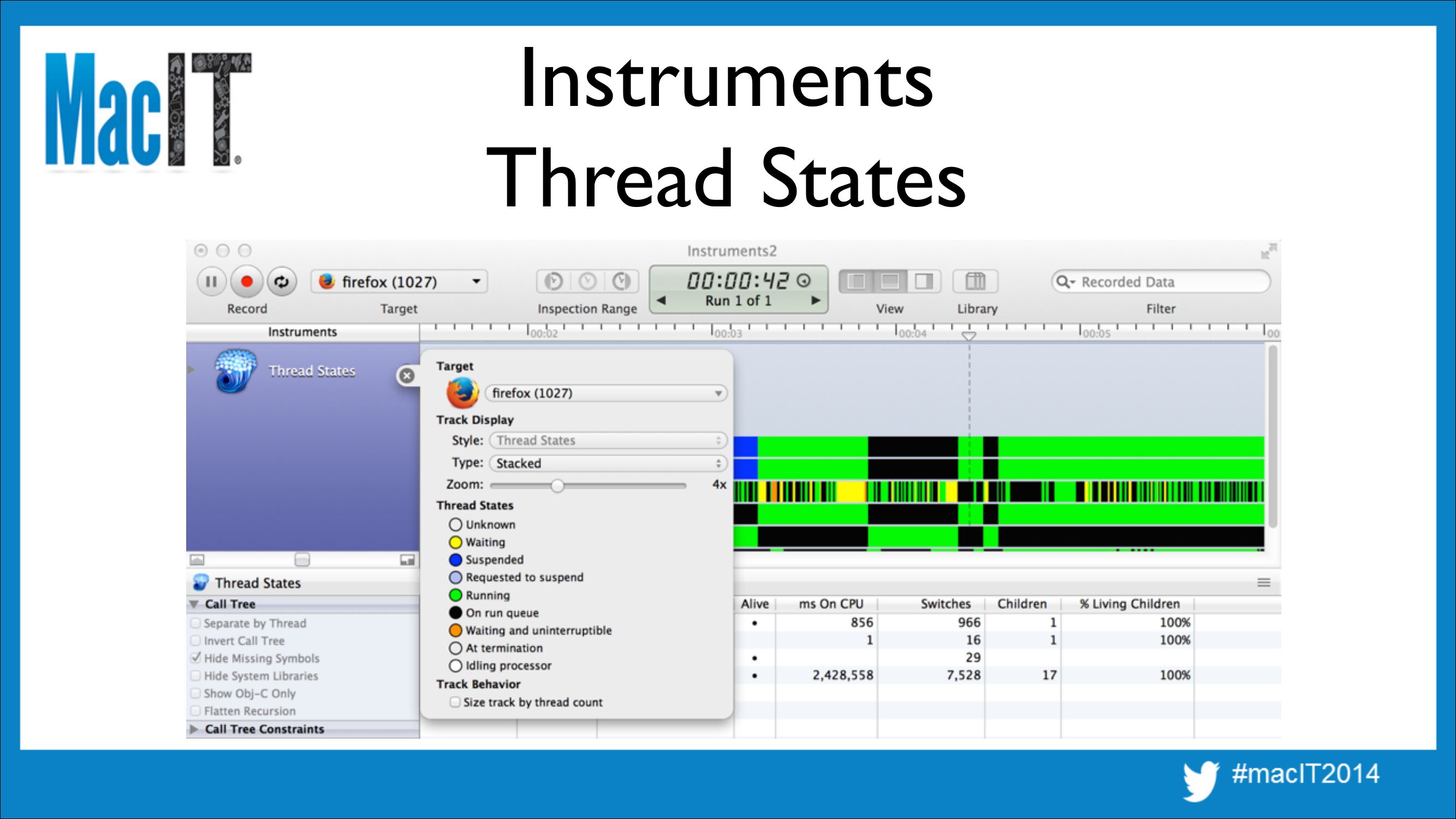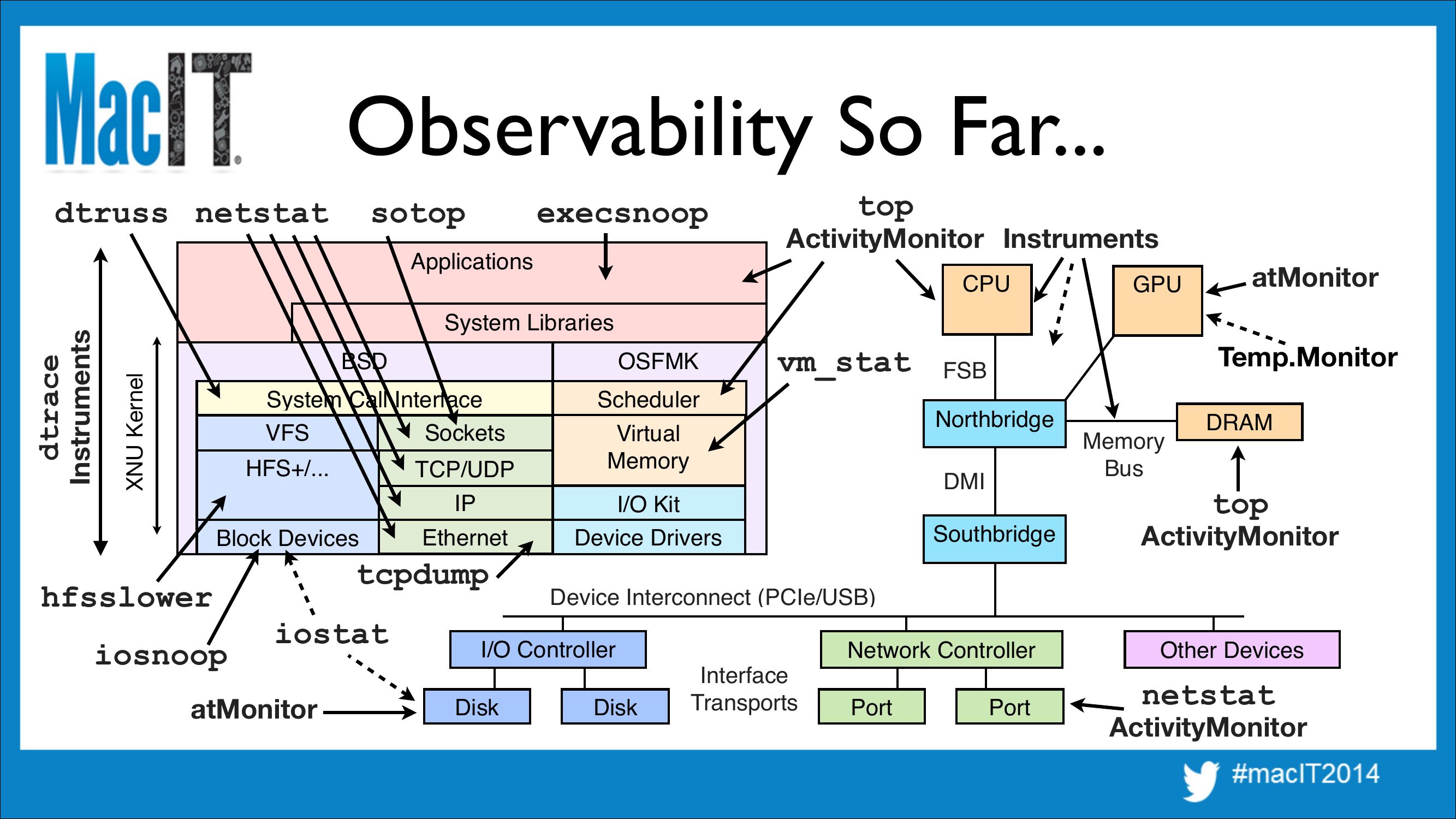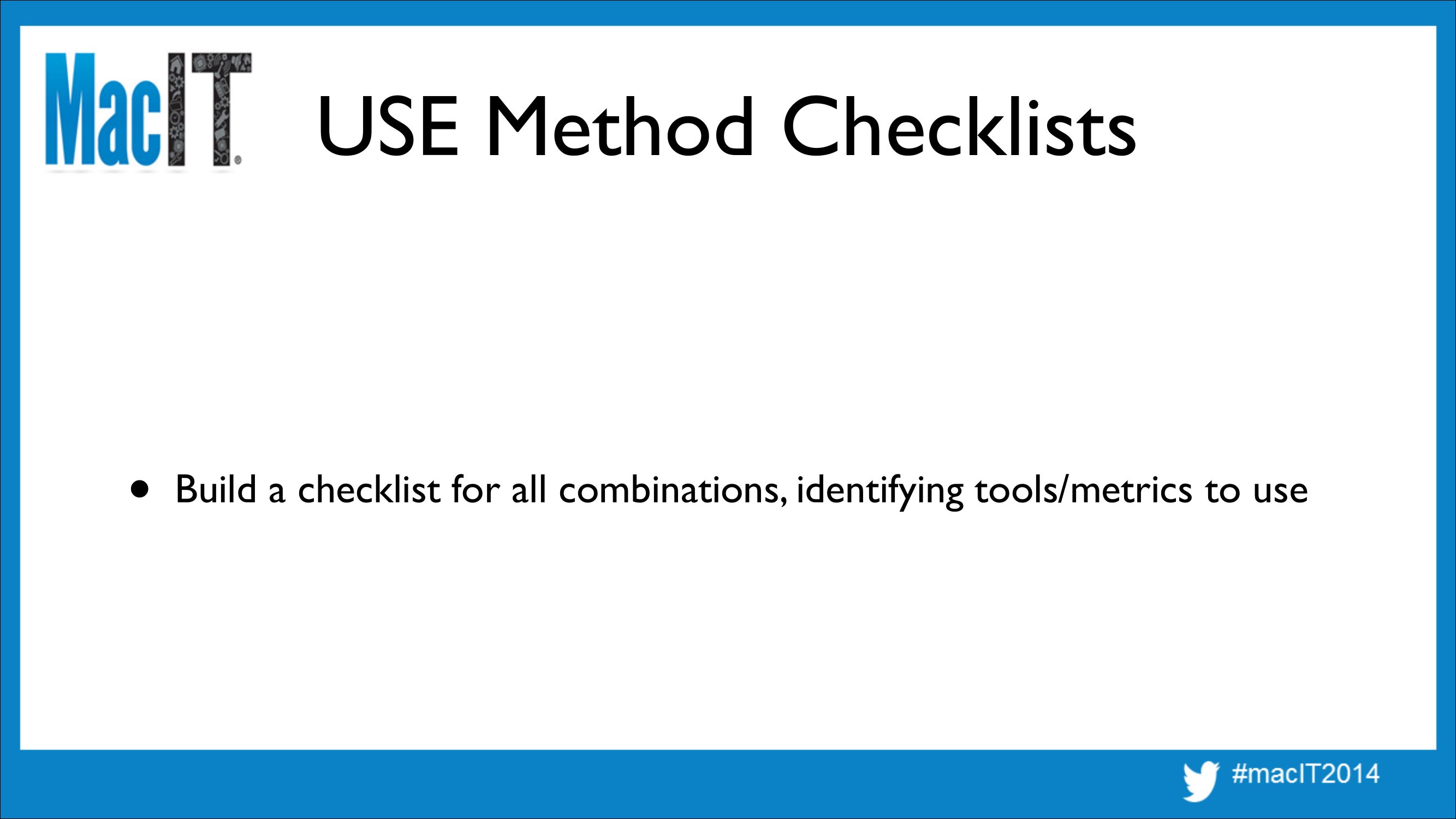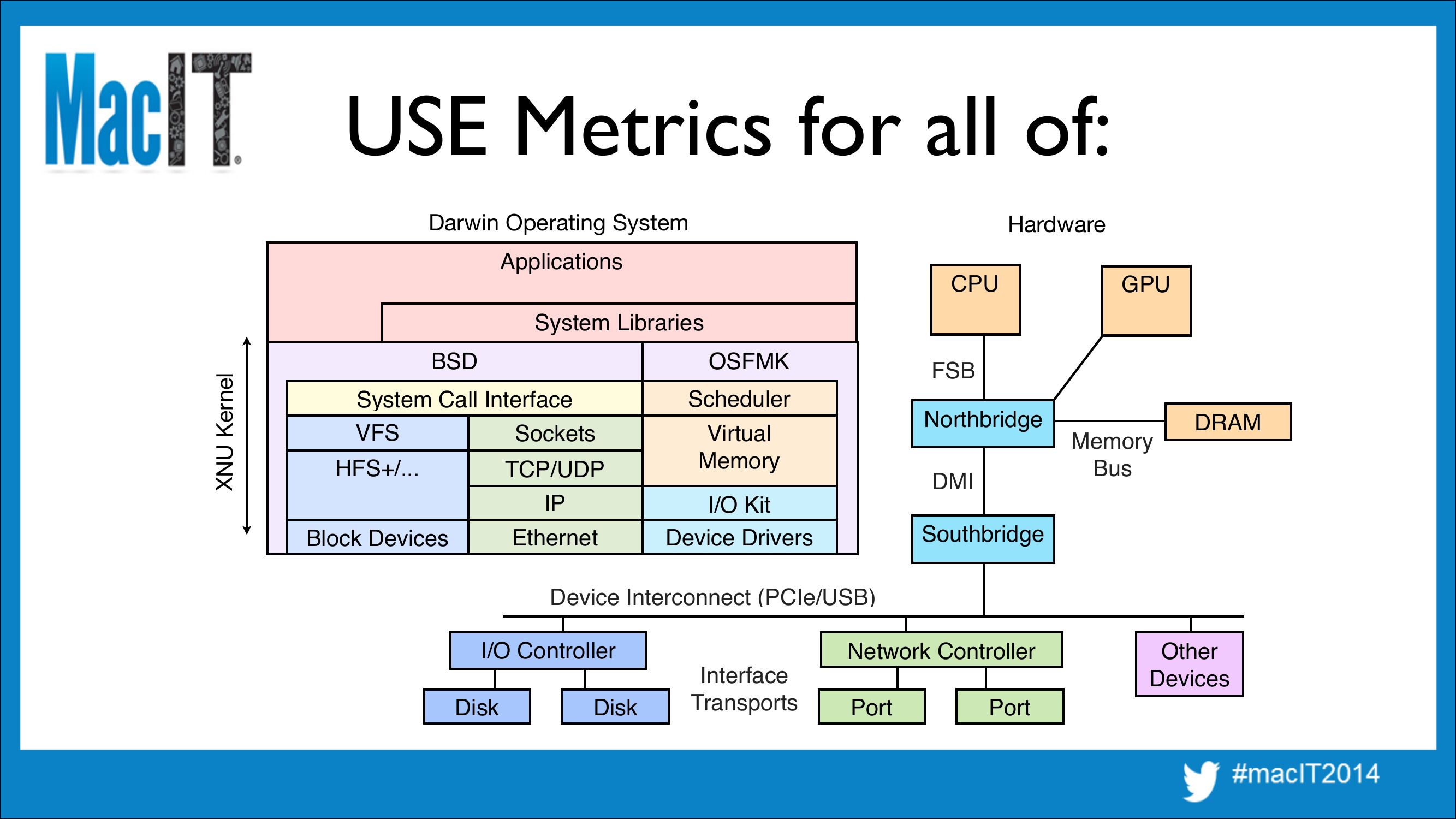MacIT 2014: Analyzing OS X Systems Performance with the USE Method
Talk for MacIT 2014, by Brendan Gregg.Description: "This talk is about systems performance on OS X, and introduces the USE Method to check for common performance bottlenecks and errors. This methodology can be used by beginners and experts alike, and begins by constructing a checklist of the questions we’d like to ask of the system, before reaching for tools to answer them. The focus is resources: CPUs, GPUs, memory capacity, network interfaces, storage devices, controllers, interconnects, as well as some software resources such as mutex locks. These areas are investigated by a wide variety of tools, including vm_stat, iostat, netstat, top, latency, the DTrace scripts in /usr/bin (which were written by Brendan), custom DTrace scripts, Instruments, and more. This is a tour of the tools needed to solve our performance needs, rather than understanding tools just because they exist. This talk will make you aware of many areas of OS X that you can investigate, which will be especially useful for the time when you need to get to the bottom of a performance issue."
| next prev 1/68 | |
| next prev 2/68 | |
| next prev 3/68 | |
| next prev 4/68 | |
| next prev 5/68 | |
| next prev 6/68 | |
| next prev 7/68 | |
| next prev 8/68 | |
| next prev 9/68 | |
| next prev 10/68 | |
| next prev 11/68 | |
| next prev 12/68 | |
| next prev 13/68 | |
| next prev 14/68 | |
| next prev 15/68 | |
| next prev 16/68 | |
| next prev 17/68 | |
| next prev 18/68 | |
| next prev 19/68 | |
| next prev 20/68 | |
| next prev 21/68 | |
| next prev 22/68 | |
| next prev 23/68 | |
| next prev 24/68 | |
| next prev 25/68 | |
| next prev 26/68 | |
| next prev 27/68 | |
| next prev 28/68 | |
| next prev 29/68 | |
| next prev 30/68 | |
| next prev 31/68 | |
| next prev 32/68 | |
| next prev 33/68 | |
| next prev 34/68 | |
| next prev 35/68 | |
| next prev 36/68 | |
| next prev 37/68 | |
| next prev 38/68 | |
| next prev 39/68 | |
| next prev 40/68 | |
| next prev 41/68 | |
| next prev 42/68 | |
| next prev 43/68 | |
| next prev 44/68 | |
| next prev 45/68 | |
| next prev 46/68 | |
| next prev 47/68 | |
| next prev 48/68 | |
| next prev 49/68 | |
| next prev 50/68 | |
| next prev 51/68 | |
| next prev 52/68 | |
| next prev 53/68 | |
| next prev 54/68 | |
| next prev 55/68 | |
| next prev 56/68 | |
| next prev 57/68 | |
| next prev 58/68 | |
| next prev 59/68 | |
| next prev 60/68 | |
| next prev 61/68 | |
| next prev 62/68 | |
| next prev 63/68 | |
| next prev 64/68 | |
| next prev 65/68 | |
| next prev 66/68 | |
| next prev 67/68 | |
| next prev 68/68 |
PDF: MacIT2014_Analyzing_OSX_Perf_USE_Method.pdf
Keywords (from pdftotext):
slide 1:
Analyzing OS X Systems Performance with the USE Method Brendan Gregg, Senior Performance Architect, Netflix March, 2014slide 2:
Find the Bottleneck Darwin Operating System Hardware Applications CPU GPU XNU Kernel System Libraries BSD OSFMK System Call Interface VFS Sockets HFS+/... TCP/UDP Ethernet Block Devices FSB Scheduler Northbridge Virtual! Memory DMI I/O Kit Device Drivers Memory! Bus DRAM Southbridge Device Interconnect (PCIe/USB) I/O Controller Disk Disk Network Controller Interface Transports Port Port Other Devicesslide 3:
This Talk • Summarizes casual to serious performance analysis of OS X • From the systems perspective, not the application • Many application issues can be found easily this way • Covering not just current tools, but suggestions for future work • May change how you think about performance!slide 4:
whoami • Senior Performance Architect at Netflix • Primary author of the DTrace book • Wrote many DTrace scripts included with OS X. Eg: dtruss, iosnoop, iotop, opensnoop, execsnoop, procsystime, bitesize.d, seeksize.d, setuids.d, etc... • These were ported and enhanced by Apple engineering (thanks!) • Created the USE method and USE method checklist for OS Xslide 5:
Agenda • The Tools Method • The USE Method • Future workslide 6:
The Tools Methodslide 7:
The Tools Method • A tool-based performance analysis approach, commonly followed today. For reference, I've called it the "Tools Method". • 1. List available performance tools • 2. For each tool, list its useful metrics • 3. For each metric, list possible interpretation • Simple, useful, but analysis is limited to what the tools provide easilyslide 8:
Tool Examples • Activity Monitor • atMonitor, Temperature Monitor Lite • Command Line • DTrace • Instrumentsslide 9:
Activity Monitor • High level process and system sumaries. A GUI version of top(1) • Table shows processes by %CPU, memory • CPU load over time • Quit, info, and system diagnosis buttonsslide 10:
Activity Monitor Network • Quick way to see current and recent network throughput • Like the CPU summary, shows aggregate device stats, and not per-deviceslide 11:
Activity Monitor CPU Usage • Per-CPU utilization from previous 0.5 - 5 seconds (tunable) • Handy to leave running. Look for single hot CPUs/threadsslide 12:
Activity Monitor Floating CPU Window • Earlier OS X also had a compact version (gone in Mavericks) • Was nice, but what I really want is a compact visualization for both per-CPU and historical dataslide 13:
Activity Monitor CPU/Disk Suggestion • Could show both per-device and history using a utilization heat map: • http://dtrace.org/blogs/brendan/2011/12/18/visualizing-device-utilization/slide 14:
Activity Monitor
Sample Process
• The cog button ("System
diagnostics options") has a
"Sample process" option for
profiling CPU code paths
• Explains %CPU usage
• Although output usually very
long and time consuming to
read (see scroll bar):
slide 15:Activity Monitor Flame Graphs ? • Suggestion: include a Flame Graph view • Visualizes entire profile output in one screen • http://github.com/ brendangregg/ FlameGraphslide 16:
atMonitor • 3rd party app. Version 2.7b crashes for me if "Top Window" is visible. • Shows many useful metrics: per-CPU, RAM, GPU, per-disk, and pernetwork interface utilization perentages with histories. • Currently the easiest way to see GPU, disk, and network utilization. • Utilization is easy to interpret. I/O per second is not.slide 17:
Temperature Monitor Lite • Another 3rd party application • Easy way to infer GPU utilization • Normal: • Video:slide 18:
Command Line • Accessed via the Terminal application • Numerous performance tools available, from UNIX/BSD/OSX • Eg, the uptime(1) command shows recent and historic CPU load: $ uptime 14:36 up 43 days, 2:39, 30 users, load averages: 0.72 1.02 1.29 • There numbers are the 1, 5, and 15 minute load averages.Values are really constants in an exponential decay moving sum. • Interpret: if average >gt; number of CPUs, then CPUs are overloadedslide 19:
Command Line: top • top(1): high level process and system summary: $ top -o cpu Processes: 272 total, 4 running, 268 sleeping, 1546 threads 14:47:36 Load Avg: 1.14, 0.75, 0.95 CPU usage: 13.95% user, 2.78% sys, 83.26% idle SharedLibs: 12M resident, 5112K data, 0B linkedit. MemRegions: 339218 total, 6689M resident, 184M private, 2153M shared. PhysMem: 3429M wired, 6502M active, 5910M inactive, 15G used, 537M free. VM: 552G vsize, 1052M framework vsize, 111312590(1) pageins, 1437348(0) pageouts Networks: packets: 120030109/127G in, 70582570/38G out. Disks: 22089197/1050G read, 26756359/1163G written. hey... PID COMMAND %CPU TIME #TH bash 100.0 47:42.28 1/1 94370 top 17.2 00:03.77 1/1 52617 firefox 47:30:58 45/1 92489- Google Chrom 2.2 13:31.85 34 [...] #WQ #PORT #MREGS RPRVT RSHRD 236K 816K 4368K 216K 576- 177307+ 1984M+ 200M 273M 271M RSIZE 760K 5116K 2530M+ 734Mslide 20:
Command Line: vm_stat • vm_stat(1): virtual memory statistics, including free memory, paging $ vm_stat 1 Mach Virtual Memory Statistics: (page size of 4096 bytes, cache hits 0%) free active spec inactive wire faults copy 0fill reactive 101297 1662K 29920 1509998 888520 17650M 106072K 15926M 6833792 100919 1658K 29920 1509998 893230 101183 1658K 29918 1509998 893169 100517 1658K 29921 1509998 893354 96590 1657K 29923 1514414 894426 93184 1662K 28486 1514414 894484 91224 1663K 28486 1514414 894886 89195 1649K 29924 1514413 909225 87550 1636K 29917 1514155 923179 61596 1644K 28309 1515551 941688 52932 1669K 28442 1515663 925755 76395 1681K 28417 1515685 889983 73520 1679K 28449 1515777 894905 60335 1684K 29073 1515560 903152 [...] pageins 111312K pageoutslide 21:
Command Line: iostat • iostat(1): block device I/O statistics. Disks, USB drives. $ iostat 1 disk0 KB/t tps MB/s 47.03 13 0.60 972.42 19 18.02 315.60 10 3.08 1 0.00 8 7.99 1024.00 18 17.97 1024.00 17 16.98 165.27 272 43.84 1024.00 18 17.98 [...] disk2 cpu load average KB/t tps MB/s us sy id 15m 0 0.00 5 2 92 0.94 1.01 0.99 128.00 141 17.60 2 3 95 0.94 1.01 0.99 128.00 24 3.00 6 2 92 0.94 1.01 0.99 0 0.00 6 2 92 0.94 1.01 0.99 128.00 69 8.61 6 2 92 0.94 1.01 0.99 128.00 143 17.85 2 2 95 0.86 0.99 0.99 128.00 142 17.72 2 2 96 0.86 0.99 0.99 127.13 146 18.10 6 5 89 0.95 1.01 0.99 128.00 143 17.85 2 2 96 0.95 1.01 0.99 • No percent utilization/busy, like other OSes? Makes it hard to interpret.slide 22:
Command Line: netstat • netstat(1): various network statistics. -i for interface stats: $ netstat -iI en0 1 input (en0) packets errs bytes packets [...] output errs bytes colls • No percent utilization, but can figure it out: throughput / known maxslide 23:
Command Line: tcpdump • tcpdump(1): sniff and examine network packets: $ tcpdump -n tcpdump: verbose output suppressed, use -v or -vv for full protocol decode listening on en0, link-type EN10MB (Ethernet), capture size 65535 bytes 18:00:55.228744 IP 10.0.1.92.53 >gt; 10.0.1.148.49228: 26359 1/0/0 A 69.192.253.15 (81) 18:00:55.311056 ARP, Reply 10.0.1.162 is-at 2c:54:2d:a4:25:4c, length 28 18:00:55.342793 IP 74.125.28.189.443 >gt; 10.0.1.148.62998: Flags [P.], seq 3544891232:3544891287, ack 3832081572, win 661, options [nop,nop,TS val 2936982235 ecr 2331923799], length 55 18:00:55.342933 IP 10.0.1.148.62998 >gt; 74.125.28.189.443: Flags [.], ack 55, win 8188, options [nop,nop,TS val 2331932237 ecr 2936982235], length 0 18:00:56.477029 IP 10.0.1.148.50359 >gt; 67.195.141.201.443: Flags [P.], seq 696365506:696365533, ack 1903095540, win 16384, length 27 18:00:56.477158 IP 10.0.1.148.50359 >gt; 67.195.141.201.443: Flags [F.], seq 27, ack 1, win 16384, length 0 [...] • Also dump to a file and examine later. Does incur overhead.slide 24:
Observability So Far... • We can see all the things! • Not really...slide 25:
Observability So Far... top netstat Darwin Operating System ActivityMonitor Applications Hardware CPU GPU atMonitor XNU Kernel System Libraries BSD OSFMK System Call Interface VFS Sockets HFS+/... TCP/UDP Block Devices Ethernet tcpdump iostat atMonitor vm_stat Scheduler Northbridge Virtual! Memory DMI I/O Kit Device Drivers Memory! Bus DRAM top Southbridge ActivityMonitor Device Interconnect (PCIe/USB) I/O Controller Disk Temp.Monitor FSB Disk Network Controller Interface Transports Port Port Other Devices netstat ActivityMonitorslide 26:
DTrace • Programmable, real-time, dynamic and static tracing • Write your own one-liners and scripts, or use other people's; including those in /usr/bin • There is a great book about it...slide 27:
DTrace: Scripts • Over 40 DTrace scripts are shipped with OS X (which I mostly wrote originally). Listing them: $ man -k dtrace bitesize.d(1m) cpuwalk.d(1m) creatbyproc.d(1m) dappprof(1m) dapptrace(1m) diskhits(1m) dispqlen.d(1m) dtrace(1) dtruss(1m) errinfo(1m) execsnoop(1m) [...] - analyse disk I/O size by process. Uses DTrace - Measure which CPUs a process runs on. Uses DTrace - snoop creat()s by process name. Uses DTrace - profile user and lib function usage. Uses DTrace - trace user and library function usage. Uses DTrace - disk access by file offset. Uses DTrace - dispatcher queue length by CPU. Uses DTrace - generic front-end to the DTrace facility - process syscall details. Uses DTrace - print errno for syscall fails. Uses DTrace - snoop new process execution. Uses DTraceslide 28:
DTrace: iosnoop • iosnoop(1m): trace block device I/O $ iosnoop UID PID D BLOCK SIZE COMM PATHNAME 176 R 148471184 8192 SystemUIServer ??/vm/swapfile10 176 R 835310312 4096 SystemUIServer ??/vm/swapfile4 503 92489 W 746204600 61440 Google Chrome ??/Chrome/.com.google.Chrome.hw1Inp 503 92489 W 746204720 23472 Google Chrome ??/Default/.com.google.Chrome.76k4tG 19 W 425711304 4096 syslogd ??/DiagnosticMessages/2014.02.14.asl 19 W 57246896 syslogd ??/DiagnosticMessages/StoreData 19 W 425710304 4096 syslogd ??/DiagnosticMessages/2014.02.14.asl 503 52617 W 214894232 4096 firefox ??/iw4rbel9.default/_CACHE_CLEAN_ 19 W 57246896 syslogd ??/DiagnosticMessages/StoreData 19 W 425710304 4096 syslogd ??/DiagnosticMessages/2014.02.14.asl [...] • Identify processes and files causing disk I/Oslide 29:
DTrace: hfsslower.d • hfsslower.d: trace HFS calls slower than a threshold. Eg, 10 ms: $ ~/dtbook_scripts/Chap5/hfsslower.d 10 TIME PROCESS 2014 Feb 14 17:35:59 Terminal R 5751 2014 Feb 14 17:35:59 Terminal R 6166 2014 Feb 14 17:35:59 Terminal W 11921 [...] ms FILE 16 data.data 17 data.data 15 data.data • Traces all application I/O to the file system, not just disk I/O • Script is on http://www.dtracebook.comslide 30:
DTrace: execsnoop • execsnoop(1m): trace process execution $ execsnoop -v STRTIME 2014 Feb 14 19:40:55 2014 Feb 14 19:40:55 2014 Feb 14 19:40:55 2014 Feb 14 19:40:55 2014 Feb 14 19:40:55 2014 Feb 14 19:40:56 2014 Feb 14 19:40:56 2014 Feb 14 19:40:56 2014 Feb 14 19:40:58 2014 Feb 14 19:41:03 [...] UID PID PPID ARGS 551 man 551 man 94837 groff 94837 tbl 94838 cat 94841 grotty 94841 troff 94842 less 92489 Google Chrome He 92489 Google Chrome He • Shows what programs are launchedslide 31:
DTrace: dtruss • dtruss(1m): trace system calls, from one or many processes dtruss -en bash PID/THRD ELAPSD SYSCALL(args) = return 475/0x1199: 87917 read(0x0, "a\0", 0x1) = 1 0 475/0x1199: 12 write_nocancel(0x2, "a\0", 0x1) = 1 0 475/0x1199: 3 sigprocmask(0x1, 0x0, 0x7FFF55F898E0) 475/0x1199: 2 sigaltstack(0x0, 0x7FFF55F898D0, 0x0) 475/0x1199: 48163 read(0x0, "t\0", 0x1) = 1 0 475/0x1199: 10 write_nocancel(0x2, "t\0", 0x1) = 1 0 475/0x1199: 3 sigprocmask(0x1, 0x0, 0x7FFF55F898E0) 475/0x1199: 2 sigaltstack(0x0, 0x7FFF55F898D0, 0x0) 475/0x1199: 12 write_nocancel(0x2, "m\0", 0x1) = 1 0 475/0x1199: 2 sigprocmask(0x1, 0x0, 0x7FFF55F898E0) [...] • dtruss is a script - edit it to add/modify it as desired = 0x0 0 = 0 0 = 0x0 0 = 0 0 = 0x0 0slide 32:
DTrace: sotop • sotop: summarize socket I/O by-process, top-style: $ sotop PROCESS kernel_task firefox Terminal WindowServer SIDPLAY Google Chrome H Google Chrome H clear Google Chrome [...] PID READS • Also from the DTrace book. WRITES READ_KB WRITE_KB CPUslide 33:
Instruments • Advanced analysis GUI • Includes many "Instruments", which profile applications in different ways: • Data sources include DTrace, CPU countersslide 34:
Instruments Thread Statesslide 35:
Instruments Low Level CPU Counters • Performance monitor counter (PMC) and performance monitor interrupts can be instrumented • Hard work, but can be used to understand bus and interconnect activityslide 36:
Observability So Far... dtruss netstat sotop execsnoop ActivityMonitor Instruments CPU GPU atMonitor System Libraries BSD XNU Kernel dtrace Instruments Applications top OSFMK System Call Interface Sockets VFS HFS+/... TCP/UDP Block Devices tcpdump hfsslower iosnoop Ethernet iostat atMonitor vm_stat Scheduler Virtual! Memory Northbridge DMI I/O Kit Device Drivers Memory! Bus DRAM top Southbridge ActivityMonitor Device Interconnect (PCIe/USB) I/O Controller Disk Temp.Monitor FSB Disk Network Controller Interface Transports Port Port Other Devices netstat ActivityMonitorslide 37:
Tools Method in Practice • Tools Method provides reasonable coverage • Some observability gaps, some uneven coverage • Can improve coverage by adding more tools: ps, ping, traceroute, latency, df, sysctl, plockstat, opensnoop, dispqlen.d, runocc.d, nfsstat, iopending, soconnect_mac.d, httpdstat.d, sc_usage, fs_usage, ... • I could keep covering tools for the rest of this talk...slide 38:
soconnect_mac.d,soaccept_mac.d dtruss,sc_usage errinfo,kill.d plockstat dapptrace httpdstat.d top,ps opensnoop netstat sotop execsnoop ActivityMonitor Instruments CPU GPU atMonitor System Libraries BSD XNU Kernel Instruments Applications dtrace Most DTrace scripts are in /usr/bin Some are from my DTrace book and are available online OSFMK System Call Interface VFS Sockets HFS+/... TCP/UDP Ethernet Block Devices tcpdump fs_usage hfsslower.d df,nfstat iostat iosnoop iopending maclife.d macvfssnoop.d Scheduler Virtual! Memory I/O Kit Device Drivers dispqlen.d FSB runocc.d latency Northbridge priclass.d pridist.d vm_stat atMonitor Disk Interface Transports bitesize.d seeksize.d Memory! Bus DRAM top ActivityMonitor Southbridge Custom Instruments using CPU counters/interrupts can be added for bus observability Device Interconnect (PCIe/USB) I/O Controller Disk DMI Temp.Monitor Network Controller Other Devices Port netstat Port ping traceroute ActivityMonitorslide 39:
The Focus on Tools • Useful, however, learning tools & metrics becomes laborious. • Still limited by what the tools provide, or provide easily. • You can try to approach this in a different way...slide 40:
Instead of starting with the tools, start with the questionsslide 41:
The USE Methodslide 42:
The USE Method • For every resource, check: • 1. Utilization • 2. Saturation • 3. Errorsslide 43:
The USE Method • For every resource, check: • 1. Utilization: time resource was busy, or degree used • 2. Saturation: degree of queued extra work • 3. Errors: any errorsslide 44:
Queueing System • If it helps, consider all resources as a a queueing system: • Also check errors Saturation Errors Utilizationslide 45:
Hardware Resources • CPUs • Main Memory • Network Interfaces • Storage Devices • Controllers, Interconnects • Find the functional diagram and examine every item in the data path...slide 46:
Hardware Functional Diagram • For each check: • 1. Utilization • 2. Saturation • 3. Errors CPU GPU FSB Northbridge DMI Memory! Bus DRAM Southbridge Device Interconnect (PCIe/USB) I/O Controller Disk Disk Network Controller Interface Transports Port Port Other Devicesslide 47:
USE Method Checklists • Build a checklist for all combinations, identifying tools/metrics to useslide 48:
OS X Checklist Resource Type CPU Utilization CPU Saturation CPU Errors Metricslide 49:
OS X Checklist Resource CPU CPU CPU Type Metric Utilization system-wide: iostat 1, "us" + "sy"; per-cpu: DTrace [1]; Activity Monitor → CPU Usage or Floating CPU Window; per-process:top -o cpu, "%CPU"; Activity Monitor → Activity Monitor, "%CPU"; ... Saturation system-wide: uptime, "load averages" >gt; CPU count; latency, "SCHEDULER" and "INTERRUPTS"; per-cpu: dispqlen.d (DTT), non-zero "value"; runocc.d (DTT), non-zero "%runocc"; perprocess: Instruments → Thread States, "On run queue"; DTrace [2] Errors dmesg; /var/log/system.log; Instruments → Counters, for PMC and whatever error counters are supported (eg, thermal throttling)slide 50:
OS X Checklist Resource CPU CPU CPU Type Metric Utilization system-wide: iostat 1, "us" + "sy"; per-cpu: DTrace [1]; Activity Monitor → CPU Usage or Floating CPU Window; per-process:top -o cpu, "%CPU"; Activity Monitor → Activity Monitor, "%CPU"; ... Saturation system-wide: uptime, "load averages" >gt; CPU count; latency, "SCHEDULER" and "INTERRUPTS"; per-cpu: dispqlen.d (DTT), non-zero "value"; runocc.d (DTT), non-zero "%runocc"; perprocess: Instruments → Thread States, "On run queue"; DTrace [2] Errors dmesg; /var/log/system.log; Instruments → Counters, for PMC and whatever error counters are supported (eg, thermal throttling)slide 51:
OS X Checklist, cont. Resource Type Memory Utilization Capacity Memory Saturation Capacity Errors Metricslide 52:
OS X Checklist, cont. Resource Type Memory Utilization Capacity Memory Saturation Capacity Errors Metric system-wide: vm_stat 1, main memory free = "free" + "inactive", in units of pages; Activity Monitor → Activity Monitor → System Memory, "Free" for main memory; per-process: top -o rsize, "RSIZE" is resident main memory size, "VSIZE" is virtual memory size; ps -alx, "RSS" is resident set size, "SZ" is virtual memory size; aux similarvm_stat (legacy format) system-wide: 1, "pageout"; per-process: anonpgpid.d (DTT), DTrace vminfo:::anonpgin [3] (frequent anonpgin == pain); Instruments → Memory Monitor, high rate of "Page Ins" and "Page Outs"; sysctl vm.memory_pressure [4] !System Information → Hardware → Memory, "Status" for physical failures; DTrace failed malloc()sslide 53:
OS X Checklist, cont. Resource Type Memory Utilization Capacity Memory Saturation Capacity Errors Metric system-wide: vm_stat 1, main memory free = "free" + "inactive", in units of pages; Activity Monitor → Activity Monitor → System Memory, "Free" for main memory; per-process: top -o rsize, "RSIZE" is resident main memory size, "VSIZE" is virtual memory size; ps -alx, "RSS" is resident set size, "SZ" is virtual memory size; aux similarvm_stat (legacy format) system-wide: 1, "pageout"; per-process: anonpgpid.d (DTT), DTrace vminfo:::anonpgin [3] (frequent anonpgin == pain); Instruments → Memory Monitor, high rate of "Page Ins" and "Page Outs"; sysctl vm.memory_pressure [4] !System Information → Hardware → Memory, "Status" for physical failures; DTrace failed malloc()sslide 54:
OS X Checklist, cont. • Full list: http://www.brendangregg.com/USEmethod/use-macosx.html • Includes references from earlier tablesslide 55:
Software Resources • Can be studied using USE metrics as well, if possible • OS X Checklist includes some example software resources: • Processes, file descriptors, kernel mutexes, user-level mutexesslide 56:
Mutex Lock • Can you think of what these could mean for a mutex lock?: • Utilization • Saturation • Errorsslide 57:
Mutex Lock • Can you think of what these could mean for a mutex lock?: • Utilization: held time per second • Saturation: measure of contention time or waiters • Errors: EDEADLK, EINVALslide 58:
Future Workslide 59:
Future Work • Tools/Metrics for USE Method • More methodologies, and then toolsslide 60:
USE Method Tools • Tools can be developed to fetch USE metrics more easily • Especially for busses and interconnects • Would love to see USE metrics in Activity Monitorslide 61:
USE Method New Uses • Can be applied new areas, developing new metrics • May not always work, but worth trying • Find a functional diagram of your system, application, or environment, and look for U.S.E. metrics for each componentslide 62:
USE Metrics for all of: Darwin Operating System Hardware Applications CPU GPU XNU Kernel System Libraries BSD OSFMK System Call Interface VFS Sockets HFS+/... TCP/UDP Ethernet Block Devices FSB Scheduler Northbridge Virtual! Memory DMI I/O Kit Device Drivers Memory! Bus DRAM Southbridge Device Interconnect (PCIe/USB) I/O Controller Disk Disk Network Controller Interface Transports Port Port Other! Devicesslide 63:
Stranger Example: TCP $ netstat -s tcp: 80444499 packets sent 28706719 data packets (3613656050 bytes) 76599 data packets (65712152 bytes) retransmitted 68 resends initiated by MTU discovery 41687640 ack-only packets (248964 delayed) 0 URG only packets 0 window probe packets 9286129 window update packets 707685 control packets 0 data packets sent after flow control 177149270 packets received 16296459 acks (for 3602941580 bytes) 556237 duplicate acks 0 acks for unsent data 154775303 packets (1214952475 bytes) received in-sequence 200501 completely duplicate packets (151553377 bytes) 1884 old duplicate packets 79 packets with some dup. data (17270 bytes duped) 6102493 out-of-order packets (4236017281 bytes) 67 packets (0 bytes) of data after window 0 window probes 14180 window update packets 72825 packets received after close 85 bad resets 0 discarded for bad checksums 0 discarded for bad header offset fields 0 discarded because packet too short 378961 connection requests 613 connection accepts 37 bad connection attempts 0 listen queue overflows 332688 connections established (including accepts) 381180 connections closed (including 13038 drops) 14527 connections updated cached RTT on close 14527 connections updated cached RTT variance on close 5495 connections updated cached ssthresh on close 1721 embryonic connections dropped 16204052 segments updated rtt (of 8674926 attempts) 374184 retransmit timeouts 4465 connections dropped by rexmit timeout 0 connections dropped after retransmitting FIN 91 persist timeouts 0 connections dropped by persist timeout 12784 keepalive timeouts 262 keepalive probes sent 1214 connections dropped by keepalive 1312411 correct ACK header predictions 152849516 correct data packet header predictions 17244 SACK recovery episodes 21329 segment rexmits in SACK recovery episodes 25852298 byte rexmits in SACK recovery episodes 180630 SACK options (SACK blocks) received 5682514 SACK options (SACK blocks) sent 0 SACK scoreboard overflow • "netstat -s" output has over 50 metrics for TCP • Do you understand them all? • Could USE metrics provide a high level summary, treating TCP as a software resource? (might be a stretch) [...]slide 64:
USE Method: TCP • TCP as a software resource metrics: • Utilization • Saturation • Errorsslide 65:
USE Method: TCP • TCP as a software resource metrics: • Utilization: time data was buffered per second • Saturation: listen queue overflows • Errors: bad connection attempts, bad resets, bad checksums, ... • I think I'd classify retransmits and duplicates as errors.slide 66:
Other Methodologies • Other methodologies include: • Drill Down Analysis Method • Workload Characterization • Thread State Analysis (TSA) Method • These too can pose questions that tools then answerslide 67:
References • http://www.brendangregg.com/USEmethod/use-macosx.html • http://www.brendangregg.com/usemethod.html • http://dtracebook.com - has DTrace book scripts online • http://dtrace.org/blogs/brendan/2011/10/10/top-10-dtrace-scripts-for-mac-os-x/ - utilization • http://dtrace.org/blogs/brendan/2011/12/18/visualizing-device-utilization/ heat maps • http://www.brendangregg.com/FlameGraphs/cpuflamegraphs.html - flame graphsslide 68:
Thanks • http://www.brendangregg.com • bgregg@netflix.com • @brendangregg


